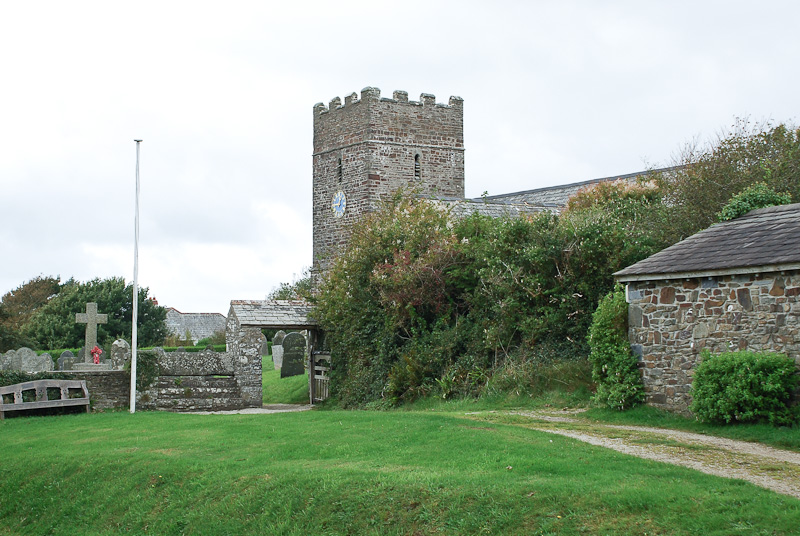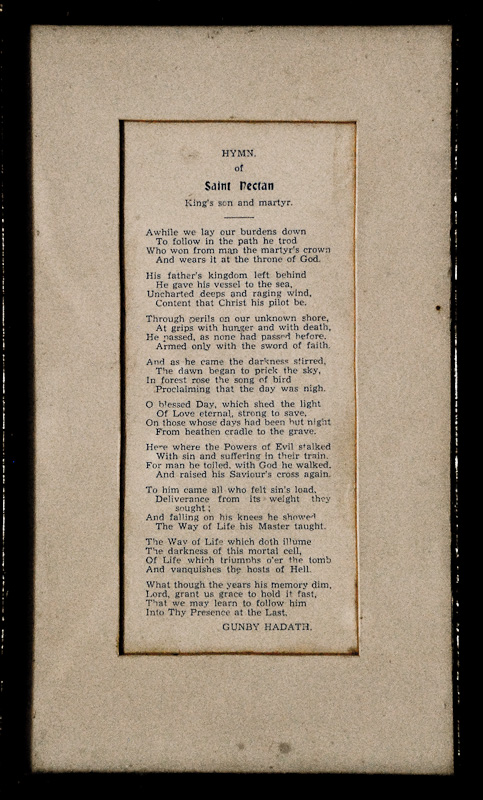St Nectan’s church at Welcombe dates back to the 11th century and was initially one of the many chapels attached to Hartland Abbey. In a peaceful location not far from the sea, the modest tower and slate gravestones evoke Cornwall rather than Devon and its most famous vicar was the Rev. Robert Stephen Hawker (1803-1875), poet, priest and antiquary, and author of ‘Trelawny’, the unofficial Cornish national anthem. For twenty-five years Hawker travelled back and forth across the county border from his own parish of Morwenstow, sometimes holding two services at Welcombe on a Sunday and returning home between each of them, riding on horseback along steep cliff-top paths.
Hawker makes many mentions of Welcombe in his letters, and in his later years, beset by financial difficulties and with a young family to support, he wrote a number of prose sketches for publication in various periodicals which were collected and published under the title Footprints of Former Men in Far Cornwall: in this collection Welcombe appears as ‘Holacombe’. The coast and farmland around Welcombe also feature in his version of the story of Cruel Coppinger, ‘the rough sea-captain, half smuggler, half pirate, who ran his lugger by beacon-light into some rugged cove among the massive headlands of the shore and was relieved of his freight by the active and diligent “country-side”’.
In his book Treachery at Sharpnose Point, Jeremy Seal touches on the Coppinger legend, while untangling the full story of the wreck of the Caledonia which took place near Morwenstow in 1842. He identifies Welcombe Mouth as the location where Coppinger swam ashore, dates the incident to 1792, and places Coppinger’s cave two miles north of Welcombe, at Sandhole.
An unexpected find inside the church was this framed copy of a ‘Hymn of Saint Nectan, King’s son and martyr’, hanging in a dark corner next to the bell tower. I’d never heard of Gunby Hadath, and the name sounded exotic enough to conjure up an image of a Victorian version of Coppinger – a rugged outsider gaining acceptance from the local community by composing songs about their patron saint.
An initial search on Google dispelled the mystique somewhat by revealing that John Edward Gunby Hadath was born in 1871 in Lincolnshire and died in Willesden, London, in 1954 – I may even have passed him in the street while being wheeled along in my pram. Despite finding plenty of evidence of his prolific output I haven’t been able to confirm much in the way of definite biographical information. The best online source seems to be an obituary which appears in a PDF of an edition of The Collector’s Digest, Vol 8, No. 87, March 1954, on the Friardale website, (follow link here and click on March/1954/087 in the table of issues). Apparently Hadath was a well known cricketer and rugger player who rose to the rank of Major during the First World War. He began writing serial stories for boys while working as a schoolmaster in Devon, and as well as using the name Gunby Hadath he also published under a variety of pen names including John Mowbray, and (possibly) James Duncan, Felix O’Grady and/or Shepherd Pearson. He wrote over 100 novels for boys on the themes of English public school life and wartime adventure and composed many lyrics for songs, the most famous of which was ‘Down the Vale’. The National Portrait Gallery website lists him as a sitter for eight photographs, but unfortunately none of the images are available to view online.
A number of similar books for girls were published under the name of Florence Gunby Hadath, and while some sources claim he wrote these himself others attribute them to his wife. (See an article about Pamela G. M. by Florence Gunby Hadath.) Gunby was a Francophile who maintained a chalet near Mont Blanc at St Gervais les Bains in North-West France and a number of his books were translated into French. He was made an honorary citizen of St Gervais in recognition of his efforts to publicise the spa town in England.
I’ve been unable to locate the school in Devon at which he was a master, but since he was clearly familiar with the story of St Nectan it seems likely that it was somewhere not too far from Welcombe – I’d be grateful if anyone can provide further information on this.
St Nectan’s well is situated on a quiet roadside just across the green from the church. The well-house is a Grade II listed building and dates from the 14th-15th century. On the day that we visited the clear water was brimming over the stone lip and the well and its surroundings all looked to be excellently cared for. A few miles north of Welcombe, in the village of Stoke, is the parish church of Hartland and another holy well, both of which are also dedicated to St Nectan.
For anyone interested in reading further on this topic, Terry Faull’s book, Secrets of the Hidden Source: In Search of Devon’s Ancient and Holy Wells is highly recommended. It was published by Halsgrove in 2004 (ISBN 1841143545) and at the time of writing a number of online sellers are offering copies for sale.
Text and photos © Angela Williams, 2011


